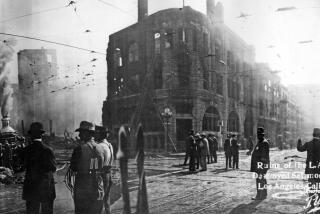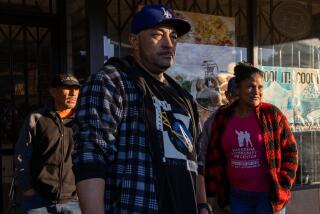Chicago at Last Hails the Victims of a Riot That Inspired Labor Day
CHICAGO â The place is Chicago: thousands of people, most in castoff clothing, marching for a cause, chanting their slogans up Michigan Avenue; demonstrations in Grant Park the next day; on the day following, the police charge a crowd of strikers, injuring untold numbers; the National Guard is called in; mass arrests; raids on the offices of the leaders of the cause; illegal surveillance by the Chicago Police Red Squad . . . does that all sound familiar?
But this is Chicago, 1886, not Chicago, 1968--a century ago this month. The marchers are in shabby garments not because of radical chic, but because itâs all they have to wear; their cause is the eight-hour day, which has been the law of the land, even in Illinois, since 1867, though no one will risk the wrath of the business-industrial Establishment by enforcing it. The marchersâ slogan is, âEight hours for work/eight hours for rest/eight hours for what we will.â They see the eight-hour day not just as a way of having more personal time while earning the same wage they are paid for 10 hours. Rather, it is also an economic measure they hope will alleviate rampant unemployment, because additional laborers would be needed to complete the same amount of work.
The demonstrations began May 1, and led up to the Haymarket Riot three days later. Of all the many riots Chicago has survived, the Haymarket affair has had more influence than any other on the history of labor in Illinois, the United States and the world, according to William Adelman, professor of labor history at the University of Illinois in Chicago.
May 1 is celebrated as Labor Day around the world, wherever such celebrations are permitted, the United States and Canada excepted. It wasnât always ignored in the city and country of its origin. In 1889, the American Federation of Labor delegate to the International Labor Congress in Paris proposed the adoption of May 1 as an international labor day. Workers were to march for the eight-hour day, democracy, the right of workers to organize and to memorialize the âMartyrs of Chicago.â
President Grover Cleveland, however, did not like the idea, not wanting a Labor Day at all. But in 1894, he suddenly announced that Labor Day in America would be the first Monday in September.
Despite its origins, May Day and the meaning of Haymarket and its eight martyrs have been largely without recognition in their own home town. The Haymarket Centennial Committee is trying to change that, to let Chicagoans know their city was the staging ground for historyâs most significant labor riot. Some facts and figures, and a few ironies:
--The incident, which lasted a mere five minutes, did not take place in Haymarket Square, but in an alley leading out of the Haymarket (one of the speakers feared that if the crowd blocked the streetcar track running down the center of the square, it would give police an excuse to break up the meeting; he should have known better--historically, the Chicago Police Department has seldom required a rationale for a little crowd bashing).
--The riot, in which seven policeman and four workers died, marked the first time dynamite was used in peacetime in this country. It was also easy to buy at local hardware stores.
--The cityâs proclamation of May as Labor History Month and May 1 as the day to commemorate the movement toward the eight-hour day, union rights and civil rights--and to recall the tragic miscarriage of justice that claimed the lives of five labor activists--marks the first time any Chicago administration has paid homage to the Haymarket victims.
--The first official event was the opening last Sunday of a Haymarket exhibition at the Chicago Historical Society, which was founded and funded by some of the same men who insisted that at least some of the Haymarket Eight must die.
At least two descendants of the eight men are taking part in the commemoration: William Neebe, 63, grandson of Oscar Neebe, and William Parsons, 46, whose great-great uncle was Albert Parsons. Oscar Neebe was a 36-year-old delivery man for a family-owned yeast business and an organizer of brewery workers, bakers and beer-wagon drivers. Parsons, 38, was a printer generally considered the leader of the eight. The others were August Spies, 30, editor of the German labor paper Arbeiter Zeitung; Michael Schwab, 32, editorial writer for the Arbeiter Zeitung and known as a first-class organizer; Louis Lingg, 21, a carpenter; Samuel Fielden, 39, a stone hauler and one-time Methodist lay preacher; George Engel, 50, a wagon driver, and Adolph Fischer, 28, a type compositor.
The eight men, who called themselves anarchists and socialists, were tried for the death of Mathias J. Degan, killed by a bomb âthrown by a person or persons unknown, but acting in conspiracyâ with the Haymarket Eight. The jury was rigged through the appointment of a special bailiff. The defense lawyer, Capt. William Black, enjoyed a distinguished corporate reputation, but was not prepared for what Gov. John Peter Altgeld described as the most rigged trial ever seen in the United States.
When it ended, Parsons, Spies, Engle and Fischer were hanged; Lingg was sentenced to die but was found the day before his scheduled execution with his face blown away, perhaps from a loaded cigar given to him by a policeman. Neebe, sentenced to 15 years; Schwab, sentenced to die but granted clemency, and Fielden, whose death sentence was commuted to life imprisonment, were pardoned in 1893 by Altgeld, who excoriated the judge, the prosecuting attorney and the police and, in effect, posthumously pardoned the men who were executed.
The Haymarket Affair is full of enigmas; perhaps during the month, between seminars, plays, films, meetings and concerts, some may be resolved. It seems unlikely, but the commemoration will fulfill Albert Parsonsâ dying wish. Just as they dropped the trap, he cried out, âLet the voice of the people be heard.â
More to Read
Sign up for Essential California
The most important California stories and recommendations in your inbox every morning.
You may occasionally receive promotional content from the Los Angeles Times.










